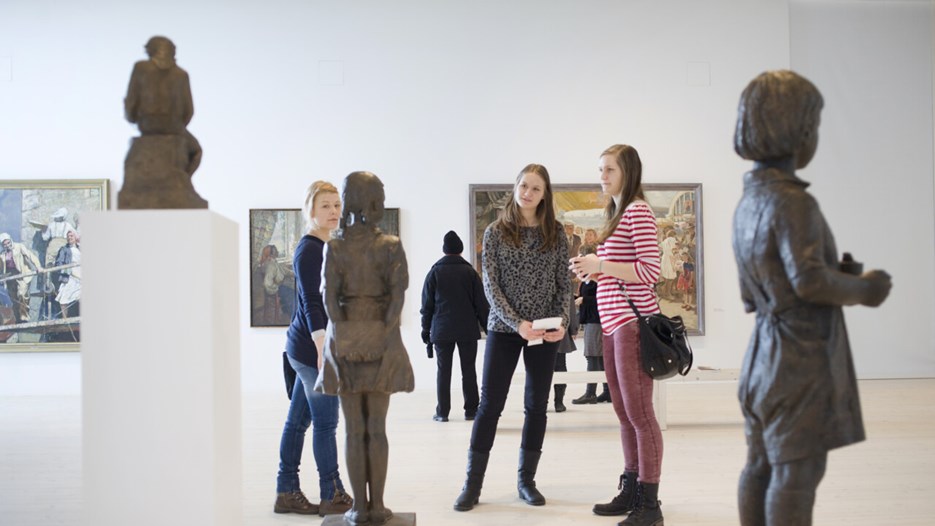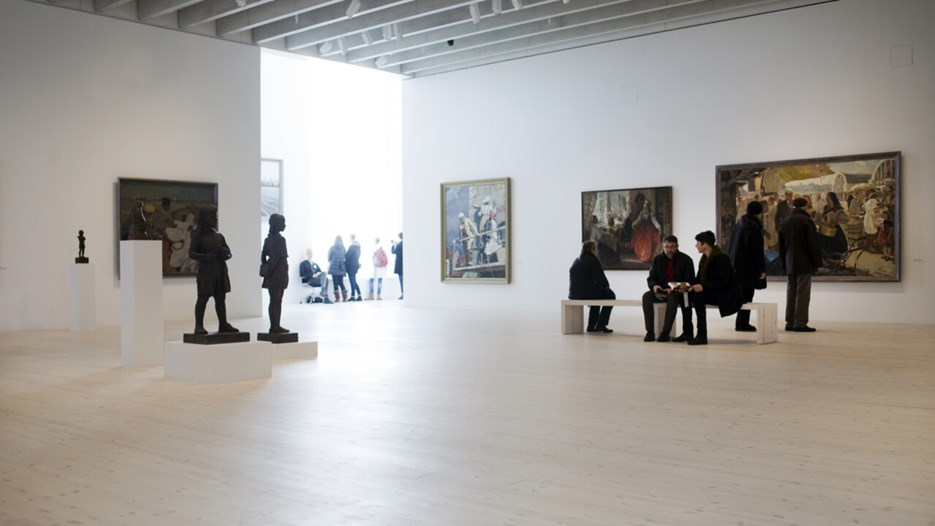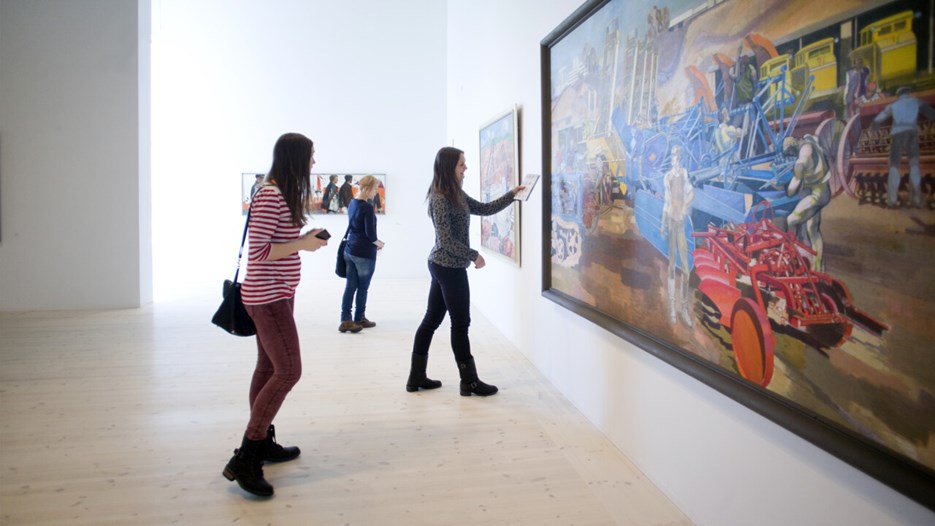
Soviet Mythology in Latvian Art. From the exhibition at Bildmuseet 2013.

Soviet Mythology in Latvian Art. From the exhibition at Bildmuseet 2013.

Soviet Mythology in Latvian Art. From the exhibition at Bildmuseet 2013.
Soviet Mythology in Latvian Art is an exhibition of paintings and sculptures from the period 1945-1985. It focuses on socialist realism as an art movement shaped by ideology and as a part of the Soviet political programme. Art was strictly regulated and the job of the artist was to articulate the ideals of communism. The myths that were formulated were about the happy Soviet society and the sense of duty, diligence and bravery of the Soviet people.
The exhibition displays pieces by Vladimirs Andrijenko, Aleksandra Briede, Jānis Briedis, Aleksejs Fjodorovs, Semjons Gelbergs, Tenis Grasis, Edgars Iltners, Eduards Kalniņš, Mihails Korņeckis, Emīls Melderis, Gunārs Mitrēvics, Anna Nollendorfa, Jānis Osis, Līvija Rezevska, Herberts Siliņš, Džemma Skulme, Aleksandrs Stankēvičs and Rita Valnere.
Soviet Mythology in Latvian Art is curated by Elita Ansone and is produced by Bildmuseet in collaboration with the Latvian National Museum of Art in Riga, Latvia.
Soviet Mythology in Latvian Art is exhibited at Bildmuseet January 27 - April 21, 2013. Here is a brief presentation of the participating artists.
Vladimirs Andrijenko
Vladimirs Andrijenko was born in the Kharkiv district in present-day Ukraine. After World War II, he studied and graduated from the Latvian Art Academy (1952). Andrijenko mainly painted compositions with many different characters - workers, collective farmers, factory workers and heroes in the Soviet Army.
Aleksandra Briede
Aleksandra Briede (1901-1992) mainly worked with sculpture. She implemented her ideas in figurative compositions, small-scale works, monuments and portraits. She was the one who introduced the subject of the child in Latvian sculpture. Her style is characterised by plastic, rounded shapes. When creating politically important commissioned work, she often chose to collaborate with her husband, Jānis Briedis. In the beginning of the 1950s, they produced official monuments of Lenin and Stalin as well as busts of Soviet leaders.
Jānis Briedis
During the first Latvian republic (1918-1940), Jānis Briedis (1902-1953) was a well-known originator of monuments and memorials. His work often contained allegories of Latvian legends and heroes. During the Soviet era, there was a sharp change in his work; the plastic forms were replaced by a rougher surface treatment with more realistic detailing.
Aleksejs Fjodorovs
Aleksejs Fjodorovs (1924-1997) was born in the Yaroslavl region in present-day Russia. During World War II, he served in an Air Force division at the Baltic front line. He studied at the art schools Gorky and Penza before he started at the Latvian Art Academy in 1950. He mainly painted thematic figure compositions depicting the Great Patriotic War and rural life.
Semjons Gelbergs
Semjons Gelbergs (1913-1975) was born in Dnipropetrovsk in present-day Ukraine and studied to become an architect in Minsk and Leningrad. He fought in World War II after which he came to Riga, where he studied at the Art Academy. Gelbergs painted in oil and watercolour and devoted himself to all permissible genres, including portraits of Lenin, Stalin and Vishinsky.
Tenis Grasis
Tenis Grasis (1925-2001) worked both with paintings, leaded glass and graphics. He studied at the Art Academy of Latvia and was a member of the Artists Association. He taught at the Art Academy from 1964. He primarily portrayed national themes that applied to the Soviet discourse.
Edgars Iltners
Edgard Iltners studied at the Art Academy of Latvia and later became active as an educator, docent and professor at the same academy from 1960 to 1983. He wrote articles on various art events on a regular basis. He tried to give the socialist realism a modern form and was the first Latvian artist to introduce the so-called harsh style in Latvian art.
Eduards Kalniņš
Eduards Kalniņš (1904-1988) was an artist and an educator. He studied under the well-known Latvian artist Vilhelms Purvītis. After World War II, he began working at the Art Academy of Latvia. Almost all artists who have graduated in Latvia after WWII have taken his course in easel painting.
Mihails Korņeckis
Mihails Korņeckis (1926-2005) was born in Moscow, but studied at the Latvian Art Academy. He was active in the Latvian Artist Association and was a veteran from World War II. He worked in all approved genres and portrayed many of Latvia's cultural personalities. He adapted his picturesque style to the socialist realism and made extensive use of communist ideology in his commissioned works.
Emīls Melderis
Emīls Melderis (1889-1979) was a sculptor and educator who worked with monuments and memorials. In the early 1920s, he was influenced by constructivism. He also produced what was known as psychological portraits. During the 1930s, he created genre figures in the form of farmers. After the war, his work changed direction, focusing instead on the academic naturalism in demand at the time.
Gunārs Mitrēvics
Gunārs Mitrēvics (1928-2007) was an artist and an educator. He taught drawing at Janis Rozentāl's art school and at the Art Academy in Riga. From 1976, he was head of the Drawing Department at the Art Academy. He worked mainly with figurative painting, but also worked as an interior designer.
Anna Nollendorfa
Anna Nollendorfa (born 1920) was both a sculptor and a doll maker. She graduated from the Art Academy of Latvia's Sculpture Department in 1951. Her degree project was entitled Lenin with children and, during her early career, she created many child sculptures. In 1955, she began working with doll making at the Latvian Puppet Theatre and Riga Cinematic Studio.
Jānis Osis
Jānis Osis (1926-1991) was known for the way he rendered light and shade in his paintings, and how he treated the relationship between bright and dark areas. He often drew by the ocean side, as he felt it had a calming and energising effect. The salt, the fresh sea air, the crude language of the fishermen, the screams of the seagulls and the horns of the boats were of great significance to him.
Līvija Rezevska
Līvija Rezevska (1926 - 2004) graduated from the Art Academy of Latvia's Sculpture Department in 1951 and worked mainly in granite, bronze and ceramics. Rezevska created many memorials and monuments.
Herberts Siliņš
Herberts Siliņš (1926-2001) chose both subjects and titles that suited socialist realism, but his primary focus was the painting itself. He worked with composition and colour range in a way that was unusual for socialist realism.
There are no signs that this artist had any communist sympathies. Towards the end of World War II, he was recruited into the German Army and returned from the war camps to Latvia in 1948. He was automatically branded as unreliable, but managed to be accepted into the Artists Association in 1960, making it possible for him to exhibit his work. His paintings, which mainly depict water landscapes, harbours, ships, cities and flowers, convey a clear influence of modernism.
Džemma Skulme
Džemma Skulme, artist and cultural activist, was one of the most influential cultural figures in Soviet era Latvia. For example, she held the position of chairperson for the Latvian Artists Association for a long period of time. During the complex Soviet times, she defended the national culture and participated in the 'Third Awakening' movement in Latvia. The movement was formed during Gorbachev's perestroika in the 1980s and led to Baltic independence from the Soviet Union.
Aleksandrs Stankēvičs
The artist and illustrator Aleksandrs Stankēvičs (born 1932) graduated from the Art Academy of Latvia's Painting Department in 1956. He worked on many interior design projects, but also painted portraits as well as historical and symbolic compositions.
Rita Valnere
Rita Valnere taught at the Art Academy of Latvia between 1967 and 2000. She worked in all permissible genres and painted primarily in oil and pastel. Valnere is especially known for her portraits where she has focused on depicting the person's spiritual nature. Her compositions are characterised by a thoughtful and poetic worldview. On occasion she depicts personal experiences through the use of allegories and historical events.